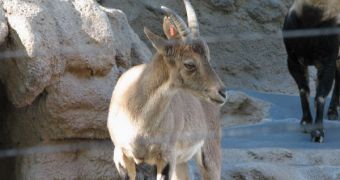Researchers from the Center of Food Technology and Research of Aragon, in Spain, led by Dr Jose Folch, have managed to successfully clone an extinct subspecies of the Spanish Ibex, namely the Pyrenean Ibex (Capra pyrenaica pyrenaica), also known as the bucardo. The animal went extinct in 2000, when the last known exemplary was found dead on the mountainous hillside of northern Spain. At the time, the people who found the animal had the inspiration to preserve a piece of its skin, which was used for the procedure.
Despite the fact that the new creature was born with a lung defect and died soon after birth, scientists now maintain that it's possible to bring back animals that were driven to extinction by factors outside natural selection, such as hunting and reduced natural habitat. In the case of the bucardo, the former was the main cause of its disappearance, as, by the end of the 19th century, only 100 of these beautiful creatures were left in Spain.
The very-well-preserved skin sample was crucial for the researchers involved in the cloning process, as it offered a rich amount of DNA, which the experts could then sequence. "The delivered kid was genetically identical to the bucardo. In species such as bucardo, cloning is the only possibility to avoid its complete disappearance," Folch says.
"I think this is an exciting advance, as it does show the potential of being able to regenerate extinct species. Clearly, there is some way to go before it can be used effectively, but the advances in this field are such that we will see more and more solutions to the problems faced," Edinburgh University Medical Research Council's Reproductive Sciences Unit director, professor Robert Miller, adds. He runs the cloning program for the northern white rhino, which is funded by the Royal Zoological Society of Scotland.
The advancements in the field of cloning are truly remarkable, as evidenced by the fact that Japanese researchers are themselves closing in on finishing the sequencing process for the DNA of the woolly mammoth, which means that the world could soon see the appearance of these long-extinct beasts.
In a bid to make further cloning attempts possible, the Zoological Society of London, in the UK, and the Natural History Museum, in the US, have joined hands in creating the world's largest frozen DNA data bank, which will store samples gathered from most animals that are threatened by extinction today. Maybe, this "Frozen Ark" will make it possible for future scientists to refine the process of cloning, and bring back these creatures.

 14 DAY TRIAL //
14 DAY TRIAL //